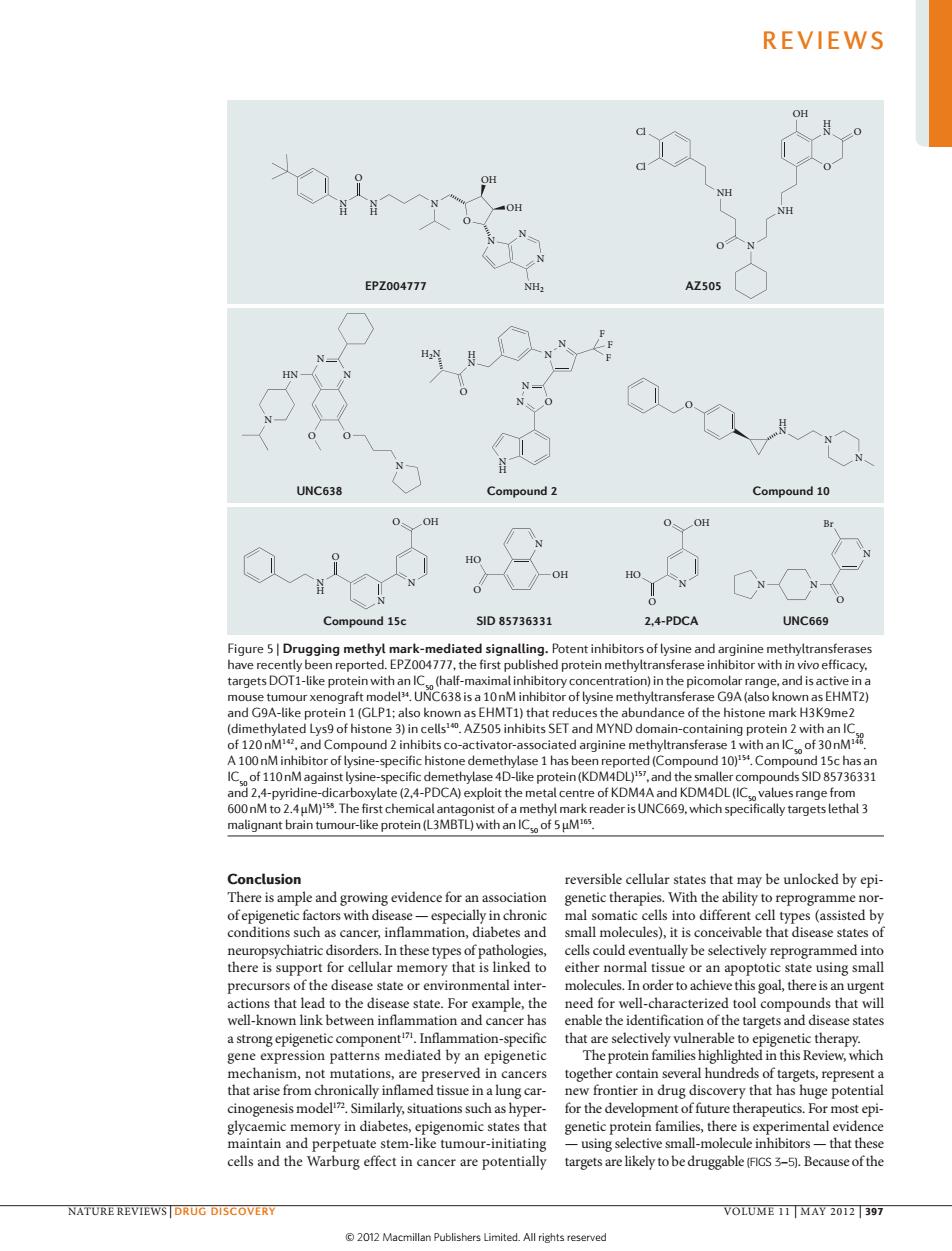正在加载图片...

REVIEWS OH PZ00477 N NC63 nd 10 ompound 15 1D85736331 JNC669 atedsignaling.-Potentinhbitosoftlysineandarg en report d protein methy a)in th d e of the hist nark H3K spec hc histon CA)exp malignant brain tumour-like protein (L3MBTL)with Conclusion reversible cellular states that may be unlocked by epi- ammation,diabetes and small mol disease statesof there is supp precursors molecules.In order to achie s goal,there is a mmation-specific echanism.not uta are pre ved in cancers together contain veral hundreds of targets.represent hat arise from trontier in drug di covery that has huge potenti mic memory in diabetes omic state enetic p families there is tumour-initiat sing s -mol e that g cr ae po argets a NATURE REVIEWSIDRUG DISCOVERY VOLUME 11 MAY 2012 397Nature Reviews | Drug Discovery N NH OH H N O O NH Cl Cl O HO O OH N N H N O OH N O N N H N O N N N Br O EPZ004777 AZ505 Compound 15c SID 85736331 UNC669 UNC638 Compound 2 Compound 10 2,4-PDCA N N H N H O N NH2 N N OH OH O N O OH HO O N N O O N HN N N H O N N N N F F H F N O H2N Conclusion There is ample and growing evidence for an association of epigenetic factors with disease — especially in chronic conditions such as cancer, inflammation, diabetes and neuropsychiatric disorders. In these types of pathologies, there is support for cellular memory that is linked to precursors of the disease state or environmental interactions that lead to the disease state. For example, the well-known link between inflammation and cancer has a strong epigenetic component171. Inflammation-specific gene expression patterns mediated by an epigenetic mechanism, not mutations, are preserved in cancers that arise from chronically inflamed tissue in a lung carcinogenesis model172. Similarly, situations such as hyperglycaemic memory in diabetes, epigenomic states that maintain and perpetuate stem-like tumour-initiating cells and the Warburg effect in cancer are potentially reversible cellular states that may be unlocked by epigenetic therapies. With the ability to reprogramme normal somatic cells into different cell types (assisted by small molecules), it is conceivable that disease states of cells could eventually be selectively reprogrammed into either normal tissue or an apoptotic state using small molecules. In order to achieve this goal, there is an urgent need for well-characterized tool compounds that will enable the identification of the targets and disease states that are selectively vulnerable to epigenetic therapy. The protein families highlighted in this Review, which together contain several hundreds of targets, represent a new frontier in drug discovery that has huge potential for the development of future therapeutics. For most epigenetic protein families, there is experimental evidence — using selective small-molecule inhibitors — that these targets are likely to be druggable (FIGS 3–5). Because of the Figure 5 | Drugging methyl mark-mediated signalling. Potent inhibitors of lysine and arginine methyltransferases have recently been reported. EPZ004777, the first published protein methyltransferase inhibitor with in vivo efficacy, targets DOT1-like protein with an IC50 (half-maximal inhibitory concentration) in the picomolar range, and is active in a mouse tumour xenograft model34. UNC638 is a 10nM inhibitor of lysine methyltransferase G9A (also known as EHMT2) and G9A‑like protein 1 (GLP1; also known as EHMT1) that reduces the abundance of the histone mark H3K9me2 (dimethylated Lys9 of histone 3) in cells140. AZ505 inhibits SET and MYND domain-containing protein 2 with an IC50 of 120nM142, and Compound 2 inhibits co-activator-associated arginine methyltransferase 1 with an IC50 of 30nM146. A 100nM inhibitor of lysine-specific histone demethylase 1 has been reported (Compound 10)154. Compound 15c has an IC50 of 110nM against lysine-specific demethylase 4D‑like protein (KDM4DL)157, and the smaller compounds SID 85736331 and 2,4-pyridine-dicarboxylate (2,4-PDCA) exploit the metal centre of KDM4A and KDM4DL (IC50 values range from 600nM to 2.4μM)158. The first chemical antagonist of a methyl mark reader is UNC669, which specifically targets lethal 3 malignant brain tumour-like protein (L3MBTL) with an IC50 of 5μM165. REVIEWS NATURE REVIEWS | DRUG DISCOVERY VOLUME 11 | MAY 2012 | 397 © 2012 Macmillan Publishers Limited. All rights reserved